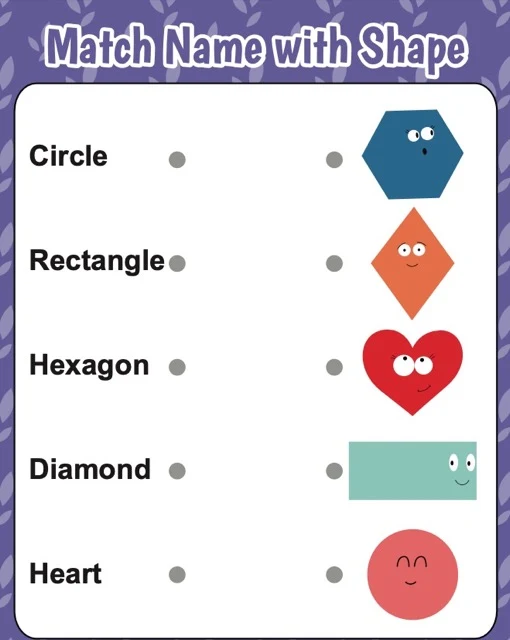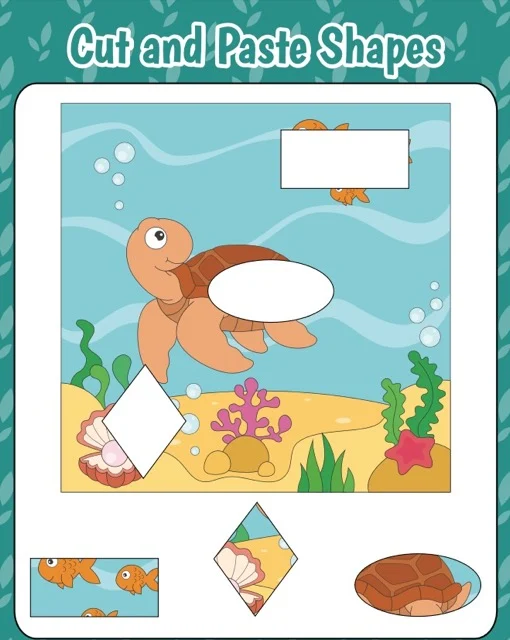Shapes in Early Childhood Education
Three sources—a study guide, a main text, and a testing document—explore the use of shape activities in early childhood education. They emphasize the importance of hands-on learning to develop visual discrimination and shape recognition skills. A variety of activities, including sorting, matching, and drawing, are presented, highlighting their integration into other subjects and real-world applications. The target audience is preschool and early elementary students, with activities applicable across diverse learning environments. The overall goal is to foster a meaningful and engaging understanding of shapes.Shape Activities for Young Learners
Briefing Doc: Shape Activities for Young Learners
Overview: This briefing doc analyzes three sources related to shape activities for young learners: "Shape Activities Study Guide for Young Learners," "Shape Activities for Young Learners," and "Testing Theme: Shape Activities.pdf." The sources provide a comprehensive overview of the benefits, types, and implementation of shape activities in early childhood education.
Main Themes:
●
Importance of Visual Discrimination: Shape activities play a crucial role in developing visual discrimination skills in young children. This ability to differentiate between objects based on their visual characteristics is fundamental for various cognitive processes. "Shape Activities Study Guide for Young Learners" emphasizes that "visual discrimination is the ability to differentiate between objects based on their visual characteristics, such as shape, color, size, and pattern."
●
Engaging Learning through Hands-on Activities: All sources highlight the effectiveness of hands-on activities for teaching shapes. "Shape Activities for Young Learners" explains that "hands-on activities offer several advantages over passive learning" including engagement, concrete understanding, and active learning. Examples of such activities include shape sorting, matching, drawing, and real-world object recognition.
●
Variety of Shape Activities: The sources showcase a diverse range of activities that cater to different learning styles and skill levels. Examples include:
○
Shape identification: Picking out specific shapes from a group ("Shape Activities Study Guide for Young Learners").
○
Shape counting: Determining the number of times a shape appears ("Testing Theme: Shape Activities.pdf").
○
Shape matching: Connecting shapes with their names ("Shape Activities for Young Learners").
○
Shape drawing: Completing drawings by adding missing shape components ("Shape Activities for Young Learners").
●
Integration with Other Subjects: Shape activities can be seamlessly integrated with other subject areas. "Shape Activities Study Guide for Young Learners" encourages educators to "integrate shape activities into other subject areas, such as art, language, or science, to create a more holistic learning experience." For instance, children can create shape collages in art class or use shapes to represent objects in science experiments.
●
Real-World Connections: Incorporating real-world objects into shape lessons helps children understand the relevance of geometric concepts in their everyday lives. "Shape Activities Study Guide for Young Learners" states that "using real-world objects helps children connect abstract geometric concepts to their everyday experiences, making learning more meaningful and relevant."
Key Facts:
●
Targeted Shapes: Activities typically cover basic 2D shapes such as circles, squares, triangles, rectangles, ovals, stars, hearts, diamonds, pentagons, hexagons, and octagons. ("Shape Activities for Young Learners")
●
Skills Developed: Shape activities promote visual discrimination, shape recognition, counting skills, fine motor skills, and spatial reasoning. ("Shape Activities for Young Learners")
●
Target Audience: The activities are primarily designed for preschool and early elementary students. ("Shape Activities for Young Learners")
●
Settings: Activities can be implemented in classrooms, homeschooling environments, and therapy sessions. ("Shape Activities for Young Learners" & "Shape Activities Study Guide for Young Learners")
Supporting Evidence from "Testing Theme: Shape Activities.pdf":
The "Testing Theme" document provides visual examples of various shape activities. It includes pages dedicated to shape matching, counting, and identifying shapes within complex scenes. This document serves as a practical illustration of the concepts and activities discussed in the other sources.
Conclusion:
Shape activities are a valuable tool for early childhood education. They promote essential cognitive and motor skills while making learning engaging and meaningful. By incorporating a variety of activities, educators and parents can effectively foster children's understanding of shapes and their significance in the world around them.
Shape Activities for Young Learners
Shape Activities FAQ
1. What basic shapes are covered in these activities?
These activities cover a range of 2D shapes including:
●
Circle
●
Square
●
Triangle
●
Rectangle
●
Oval
●
Star
●
Heart
●
Diamond
●
Pentagon
●
Hexagon
●
Octagon
2. What kinds of activities are included?
The activities utilize a variety of learning approaches:
●
Shape identification: Learners identify and color specific shapes within a larger picture.
●
Shape counting: Learners count the number of times a specific shape appears in a picture.
●
Shape matching: Learners connect images of shapes with their corresponding names.
●
Shape drawing: Learners complete drawings by adding the missing shape components.
●
Real-world shape recognition: Learners identify shapes found in everyday objects and scenes.
3. Who are these activities suitable for?
These activities are primarily designed for young learners in preschool or early elementary grades who are beginning to learn about basic geometric shapes.
4. What skills do these activities help develop?
These activities promote the development of several skills, including:
●
Visual discrimination: The ability to differentiate between different shapes.
●
Shape recognition: The ability to identify and name various shapes.
●
Counting skills: The ability to count accurately.
●
Fine motor skills: Coloring and drawing activities enhance hand-eye coordination and precision.
●
Spatial reasoning: Understanding the relationships between shapes and their positions.
5. Can these activities be used in different settings?
Yes, these activities are versatile and can be used in various settings:
●
Classroom: As part of a math lesson or activity center.
●
Homeschool: For supplemental learning or review.
●
Therapy sessions: Occupational therapists or speech therapists can use them to work on fine motor skills and visual perception.
6. Are there different levels of difficulty?
While the provided excerpts don't explicitly show varying difficulty levels, the activities naturally progress. Identifying shapes within simple pictures is easier than counting shapes within a complex scene. Educators or parents can adjust the challenge by selecting activities appropriate for the learner's current abilities.
7. What are the benefits of using hands-on shape activities?
Hands-on activities offer several advantages over passive learning:
●
Engagement: Interactive tasks capture children's attention and make learning more enjoyable.
●
Concrete understanding: Manipulating shapes and visually experiencing their properties leads to a deeper understanding of geometric concepts.
●
Active learning: Children learn best by doing, and these activities encourage active participation and exploration.
8. Can these activities be extended or modified?
Absolutely! The activities can be extended or modified to suit different learning goals:
●
Create shape collages: Have children cut out shapes from magazines or colored paper and create their own designs.
●
Shape scavenger hunt: Hide shapes around the room or outdoors and have children find them.
●
Shape sorting games: Provide a variety of shapes and have children sort them by attributes like color, size, or number of sides.
Shape Activities Study Guide for Young Learners
Shape Activities Study Guide: 2D Shapes for Young Learners
Short-Answer Quiz
Instructions: Answer the following questions in 2-3 sentences each.
1.
List five 2D shapes commonly covered in early childhood shape activities.
2.
Describe two different types of shape activities that encourage visual discrimination.
3.
Explain how shape activities can support the development of fine motor skills.
4.
Besides classrooms, name two other settings where shape activities could be effectively implemented.
5.
What is one benefit of incorporating real-world objects into shape lessons?
6.
How can educators or parents adjust the difficulty level of shape activities?
7.
Why are hands-on activities generally more effective than passive learning for young children?
8.
Suggest one way to extend a shape identification activity to make it more challenging.
9.
How does the "Testing Theme" document demonstrate the concept of shape matching?
10.
Based on the "Testing Theme" document, describe one shape counting activity.
Short-Answer Quiz Answer Key
1.
Five common 2D shapes: Circle, square, triangle, rectangle, and star. Other shapes often included are oval, heart, diamond, pentagon, hexagon, and octagon.
2.
Shape activities for visual discrimination:
○
Shape identification: Learners pick out a specific shape from a group of different shapes.
○
Shape sorting: Learners categorize shapes based on attributes like size, color, or number of sides.
3.
Fine motor skill development: Activities like coloring, drawing, cutting, and pasting shapes help develop hand-eye coordination, finger dexterity, and precise control over hand movements.
4.
Alternative settings for shape activities: Homeschooling environments and therapy sessions (occupational or speech therapy).
5.
Real-world object benefits: Using real-world objects helps children connect abstract geometric concepts to their everyday experiences, making learning more meaningful and relevant.
6.
Adjusting difficulty: Educators can modify difficulty by choosing activities appropriate to the learner's skill level. For instance, identifying shapes in a simple picture is easier than counting shapes in a complex scene.
7.
Hands-on learning effectiveness: Young children are active learners who learn best through direct experience. Hands-on activities engage their senses, encourage active participation, and promote deeper understanding compared to passive observation.
8.
Extending shape identification: Instead of simply identifying shapes, children can create a picture using different shapes or build a structure using blocks of various shapes.
9.
Shape matching in "Testing Theme": Several pages present a shape alongside its name, allowing children to match the visual representation of the shape with its corresponding word.
10.
Shape counting in "Testing Theme": Some pages display various objects within a scene and instruct the child to count the occurrences of a specific shape (e.g., count all the circles in the picture).
Essay Questions
1.
Discuss the importance of visual discrimination in early childhood development and how shape activities can support this skill.
2.
Compare and contrast the benefits of using manipulatives versus digital resources for teaching shapes to young learners.
3.
Explain how shape activities can be integrated into other subject areas, such as art, language, or science, to create a more holistic learning experience.
4.
Design a lesson plan for a specific age group (e.g., preschool or kindergarten) that focuses on introducing a new shape. Include a variety of activities that cater to different learning styles.
5.
Analyze the role of play in learning about shapes. Provide specific examples of play-based activities that can effectively teach shape concepts to young children.
Glossary of Key Terms
●
2D Shapes: Flat shapes that have only two dimensions: length and width.
●
Visual Discrimination: The ability to differentiate between objects based on their visual characteristics, such as shape, color, size, and pattern.
●
Shape Recognition: The ability to identify and name specific shapes.
●
Fine Motor Skills: The ability to make precise movements with the small muscles of the hands and fingers.
●
Spatial Reasoning: The ability to understand and manipulate the relationships between objects in space.
●
Hands-on Activities: Learning experiences that involve active participation and physical manipulation of materials.
●
Manipulatives: Physical objects, such as blocks, puzzles, or counters, that can be handled and moved to support learning.
●
Shape Matching: Connecting visual representations of shapes with their corresponding names or attributes.
●
Shape Counting: Determining the number of times a specific shape appears within a given set or scene.
●
Shape Identification: Picking out a specific shape from a group of different shapes.






































